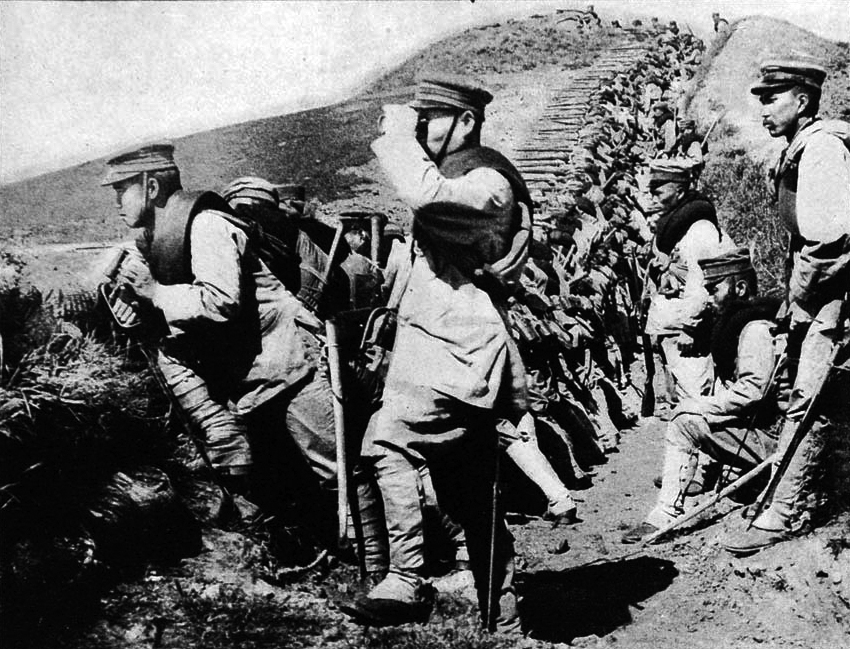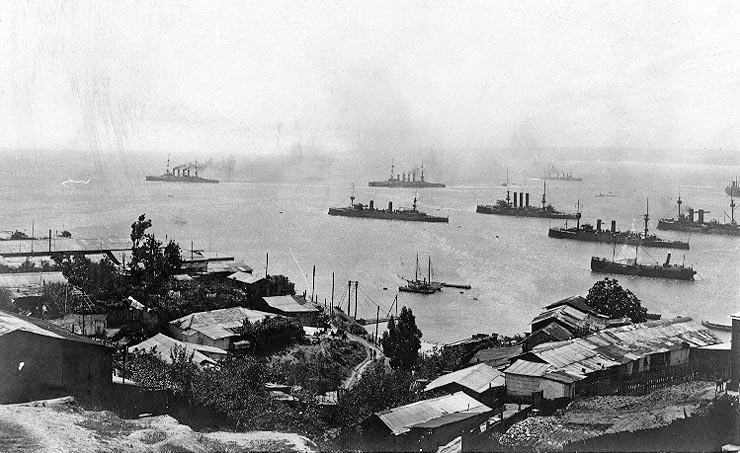|
Siege Of Tsingtao
The siege of Tsingtao (or Tsingtau) was the attack on the German port of Tsingtao (now Qingdao) in China during World War I by Japan and the United Kingdom. The siege was waged against Imperial Germany between 27 August and 7 November 1914. The siege was the first encounter between Japanese and German forces, the first Anglo-Japanese operation of the war, and the only major land battle in the Asian and Pacific theatre during World War I. Background Throughout the late 19th and early 20th centuries, Germany joined other European powers in a scramble for colonial possessions. As with the other world powers (including the United States and Japan), Germany began to interfere in Chinese local affairs. After two German missionaries were killed in the Juye Incident in 1897, China was forced to agree to the Kiautschou Bay concession in Shantung (now Shandong) to Germany in 1898 on a 99-year lease. Germany then began to assert its influence across the rest of the province and bui ... [...More Info...] [...Related Items...] OR: [Wikipedia] [Google] [Baidu] |
Japanese 18th Infantry Division
The was an infantry division of the Imperial Japanese Army. Its tsūshōgō code name was the . The 18th Division was one of two infantry divisions newly raised by the Imperial Japanese Army immediately after the Russo-Japanese War (1904–1905) as part of the post war expansion of the standing Japanese military. The division received its colors on 13 November 1907. Its original headquarters was in a suburb of the city of Kurume in Fukuoka Prefecture. Action In World War I the division was strengthened by an additional infantry brigade (the IJA 29th Brigade) and, led by Lieutenant General Kamio Mitsuomi, was given an independent command in the Siege of Tsingtao of the German colony of Tsingtao in the Shandong peninsula, China in October 1914, forcing a surrender of German forces after a week-long assault. Notably, an aircraft from divisional air force has become the first airplane ever downed in the air-to-air combat. However, on 1 May 1925, the division was dissolved ... [...More Info...] [...Related Items...] OR: [Wikipedia] [Google] [Baidu] |
Asian And Pacific Theatre Of World War I
Asian and Pacific theatre of World War I consisted of various military engagements that took place on the Asian continent and on Pacific islands. They include naval battles, the Allied conquest of German colonial possessions in the Pacific Ocean and China, and an anti-Russian rebellion in Russian Turkestan and an Ottoman-supported rebellion in British Malaya. The most significant military action was the careful and well-executed Siege of Tsingtao in China, but smaller actions were also fought at Bita Paka and Toma in German New Guinea. All other German and Austrian possessions in Asia and the Pacific fell without bloodshed. Naval warfare was common; all of the colonial powers had naval squadrons stationed in the Indian or Pacific Oceans. These fleets operated by supporting the invasions of German-held territories and by destroying the East Asia Squadron of the Imperial German Navy. Allied offensives Tsingtao Tsingtao was the most significant German base in the ... [...More Info...] [...Related Items...] OR: [Wikipedia] [Google] [Baidu] |
German East Asiatic Squadron
The German East Asia Squadron (german: Kreuzergeschwader / Ostasiengeschwader) was an Imperial German Navy cruiser squadron which operated mainly in the Pacific Ocean between the mid-1890s until 1914, when it was destroyed at the Battle of the Falkland Islands. It was based at Germany's Kiautschou Bay concession in China. Background The Treaty of Peking of September 1861 between the Kingdom of Prussia and China allowed Prussian warships to operate in Chinese waters. As East Asia grew in economic and political importance to the recently united Germany, in 1881 a flying squadron was formed for the area under the command of a flag officer. Since African colonies were then seen as of greater value, an African Cruiser Squadron was established in 1885 with permanent status, and shortly thereafter the Imperial German Navy reduced the East Asia presence to two small gunboats. From 1888 to 1892, was flagship of the German East Asia Squadron, initially under vice-admiral Karl August ... [...More Info...] [...Related Items...] OR: [Wikipedia] [Google] [Baidu] |
Northern Mariana Islands
The Northern Mariana Islands, officially the Commonwealth of the Northern Mariana Islands (CNMI; ch, Sankattan Siha Na Islas Mariånas; cal, Commonwealth Téél Falúw kka Efáng llól Marianas), is an unincorporated territory and commonwealth of the United States consisting of 14 islands in the northwestern Pacific Ocean.Lin, Tom C.W.Americans, Almost and Forgotten 107 California Law Review (2019) The CNMI includes the 14 northernmost islands in the Mariana Archipelago; the southernmost island, Guam, is a separate U.S. territory. The United States Department of the Interior cites a landmass of . According to the 2020 United States Census, 47,329 people were living in the CNMI at that time. The vast majority of the population resides on Saipan, Tinian, and Rota. The other islands of the Northern Marianas are sparsely inhabited; the most notable among these is Pagan, which for various reasons over the centuries has experienced major population flux, but formerly had r ... [...More Info...] [...Related Items...] OR: [Wikipedia] [Google] [Baidu] |
Maximilian Von Spee
Maximilian Johannes Maria Hubert Reichsgraf von Spee (22 June 1861 – 8 December 1914) was a naval officer of the German '' Kaiserliche Marine'' (Imperial Navy), who commanded the East Asia Squadron during World War I. Spee entered the navy in 1878 and served in a variety of roles and locations, including on a colonial gunboat in German West Africa in the 1880s, the East Africa Squadron in the late 1890s, and as commander of several warships in the main German fleet in the early 1900s. During his time in Germany in the late 1880s and early 1890s, he married his wife, Margareta, and had three children, his sons Heinrich and Otto and his daughter Huberta. By 1912, he had returned to the East Asia Squadron as its commander, and was promoted to the rank of '' Vizeadmiral'' (Vice Admiral) the following year. After the outbreak of World War I in July 1914, Spee led his squadron across the Pacific to the coast of South America. Here on 1 November, he defeated the British 4th Cruise ... [...More Info...] [...Related Items...] OR: [Wikipedia] [Google] [Baidu] |
Mitsuomi Kamio
was a Japanese general in the Imperial Japanese Army, who commanded the Allied land forces during the Siege of Tsingtao in World War I. Biography Kamio was the younger son of Kamio Heizaburō, a samurai retainer of the Suwa clan in Shinano province (present-day Nagano prefecture). He graduated from military academy in 1874, and served as a sergeant in the Imperial infantry during the Satsuma Rebellion of 1877. He rose rapidly through the ranks, to sergeant-major and then was commissioned as a brevet second lieutenant by the end of the same year. His commission was confirmed as official by the end of the war, and in 1882 was promoted to full lieutenant. Kamio served in Qing dynasty China as a military attaché from 1885–86, during which time he was promoted to captain. On his return to Japan, he was assigned to various staff positions, and became a major in December 1891. He returned to China again as a military attaché attached to the Japanese embassy in B ... [...More Info...] [...Related Items...] OR: [Wikipedia] [Google] [Baidu] |
Russo-Japanese War
The Russo-Japanese War ( ja, 日露戦争, Nichiro sensō, Japanese-Russian War; russian: Ру́сско-япóнская войнá, Rússko-yapónskaya voyná) was fought between the Empire of Japan and the Russian Empire during 1904 and 1905 over rival imperialism, imperial ambitions in Manchuria and the Korean Empire. The major theatres of military operations were located in Liaodong Peninsula and Shenyang, Mukden in Southern Manchuria, and the Yellow Sea and the Sea of Japan. Russia sought a Port#Warm-water port, warm-water port on the Pacific Ocean both for its navy and for maritime trade. Vladivostok remained ice-free and operational only during the summer; Lüshunkou, Port Arthur, a naval base in Liaodong Province leased to Russia by the Qing dynasty of China from 1897, was operational year round. Russia had pursued an expansionist policy east of the Urals, in Siberia and the Russian Far East, Far East, since the reign of Ivan the Terrible in the 16th century. Since th ... [...More Info...] [...Related Items...] OR: [Wikipedia] [Google] [Baidu] |
Anglo-Japanese Alliance
The first was an alliance between Britain and Japan, signed in January 1902. The alliance was signed in London at Lansdowne House on 30 January 1902 by Lord Lansdowne, British Foreign Secretary, and Hayashi Tadasu, Japanese diplomat. A diplomatic milestone that saw an end to Britain's "Splendid isolation" (a policy of avoiding permanent alliances), the Anglo-Japanese alliance was renewed and expanded in scope twice, in 1905 and 1911, playing a major role in World War I before the alliance's demise in 1921 and termination in 1923. The main threat for both sides was from Russia. France was concerned about war with Britain and, in cooperation with Britain, abandoned its ally, Russia, to avoid the Russo-Japanese War of 1904. However, Britain siding with Japan angered the United States and some British dominions, whose opinion of the Empire of Japan worsened and gradually became hostile. Motivations and reservations The possibility of an alliance between Great Britain and J ... [...More Info...] [...Related Items...] OR: [Wikipedia] [Google] [Baidu] |
Kwang-Chou-Wan
The Leased Territory of Guangzhouwan, officially the , was a territory on the coast of Zhanjiang in China leased to France and administered by French Indochina. The capital of the territory was Fort-Bayard, present-day Zhanjiang. The Japanese occupied the territory in February 1943. In 1945, following the surrender of Japan, France formally relinquished Guangzhouwan to China. The territory did not experience the rapid growth in population that other parts of coastal China experienced, rising from 189,000 in the early 20th century to just 209,000 in 1935. Industries included shipping and coal mining. Geography The leased territory was situated on the east side of the Leizhou Peninsula (french: Péninsule de Leitcheou), near Guangzhou, around a bay then called Kwangchowan, now called the Port of Zhanjiang. The bay forms the estuary of the Maxie River (Chinese: , french: Rivière Ma-The). The Maxie is navigable as far as inland even by large warships. The territory leased ... [...More Info...] [...Related Items...] OR: [Wikipedia] [Google] [Baidu] |
Leased
A lease is a contractual arrangement calling for the user (referred to as the ''lessee'') to pay the owner (referred to as the ''lessor'') for the use of an asset. Property, buildings and vehicles are common assets that are leased. Industrial or business equipment are also leased. Basically a lease agreement is a contract between two parties: the lessor and the lessee. The lessor is the legal owner of the asset, while the lessee obtains the right to use the asset in return for regular rental payments. The lessee also agrees to abide by various conditions regarding their use of the property or equipment. For example, a person leasing a car may agree to the condition that the car will only be used for personal use. The term rental agreement can refer to two kinds of leases: * A lease in which the asset is tangible property. Here, the user '' rents'' the asset (e.g. land or goods) ''let out'' or ''rented out'' by the owner (the verb ''to lease'' is less precise because it ca ... [...More Info...] [...Related Items...] OR: [Wikipedia] [Google] [Baidu] |








